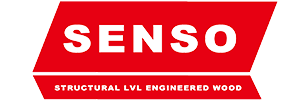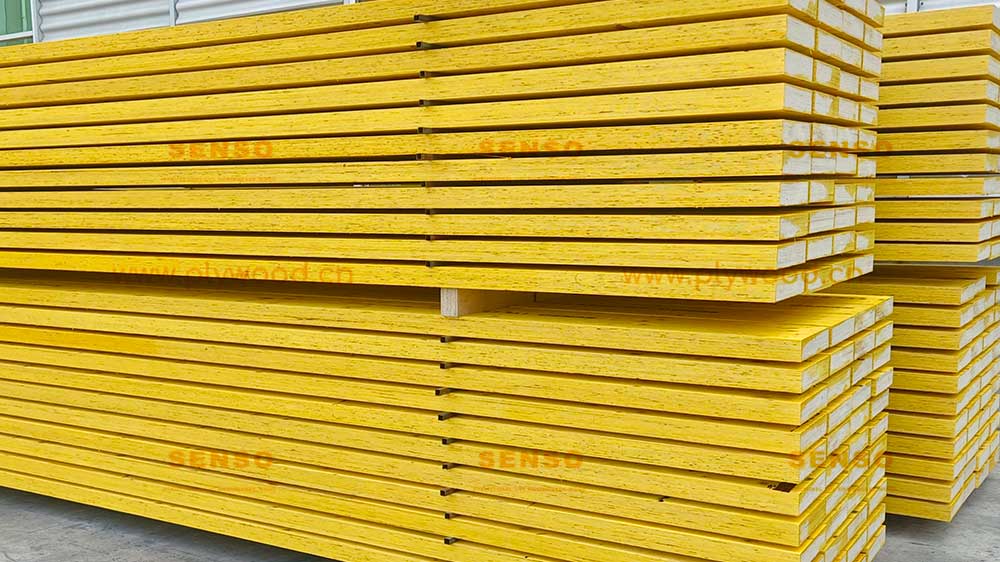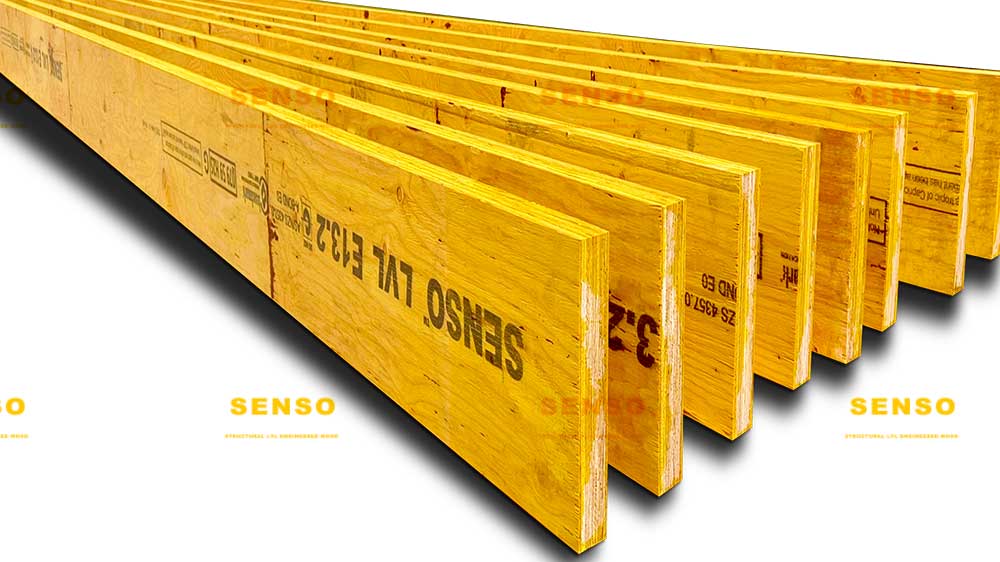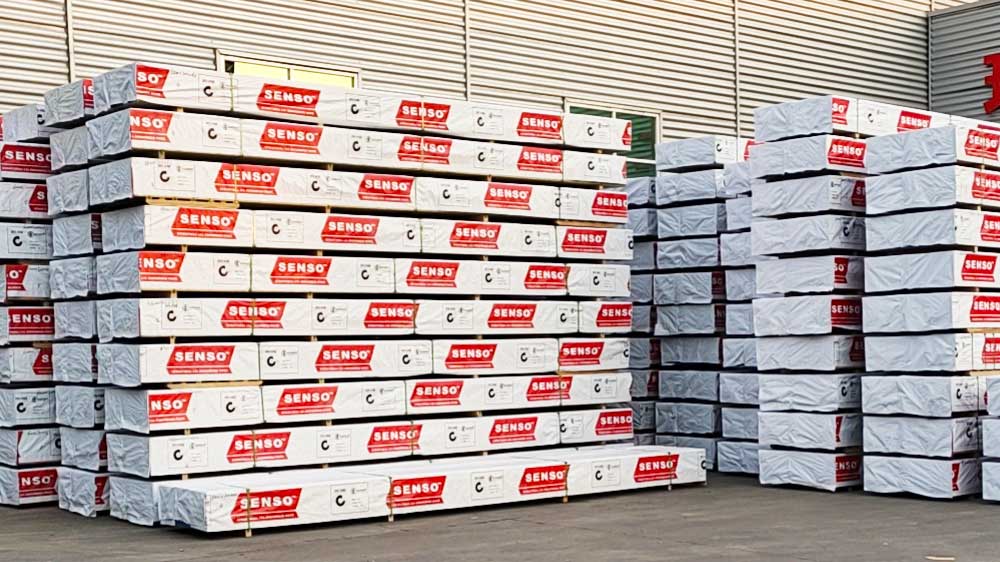What is Laminated Veneer Lumber?
Laminated veneer lumber (LVL) is an engineered wood product that redefines modern construction. LVL is created by bonding thin wood veneers together under heat and pressure. The result is a product that boasts remarkable strength, stability, and uniformity, making it a popular choice for structural applications. Whether used as laminated beams, LVL span tables, or headers, LVL wood provides a reliable solution for builders and architects alike. This innovative material combines the best characteristics of wood with advanced engineering techniques, offering a sustainable and efficient alternative to traditional solid wood.
LVL unique manufacturing process involves peeling logs into thin veneers, which are then dried, coated with adhesive, and assembled in a specific orientation. This assembly is pressed and heated to form a solid, rectangular billet. The orientation of the veneers and the use of high-quality adhesives give LVL its superior strength and load-bearing capacity, allowing it to outperform conventional lumber in many applications.
The Advantages of Laminated Veneer Lumber
Strength and Durability
LVL is renowned for its exceptional strength-to-weight ratio. This attribute makes it ideal for structural components such as LVL beams and headers. Unlike traditional lumber, which can have inconsistencies and defects, LVL engineered nature ensures uniformity and predictability. This consistency translates to enhanced durability, reducing the likelihood of warping, twisting, or splitting over time.
Versatility in Applications
LVL versatility is one of its most significant advantages. It can be used in a wide range of applications, from floor joists and roof beams to wall studs and window frames. The material’s adaptability makes it a go-to choice for builders looking to optimize both performance and cost-efficiency. Whether it’s an LVL span table or an LVL beam, the material’s flexibility ensures it can meet the diverse demands of modern construction.
Sustainable and Environmentally Friendly
Sustainability is a critical consideration in today’s construction industry, and LVL meets this demand admirably. The production process of LVL makes efficient use of timber resources, reducing waste compared to traditional lumber production. Additionally, the adhesives used in LVL manufacturing are designed to minimize environmental impact, making LVL a greener choice for eco-conscious builders.
Applications of Laminated Veneer Lumber
Structural Components
LVL is commonly used in structural components such as beams, headers, and columns. Its superior strength and stiffness make it an excellent choice for load-bearing applications. LVL beams, for instance, can span longer distances without support, allowing for more open and flexible architectural designs. This capability is particularly advantageous in large-scale commercial projects where long spans are essential.
Flooring and Roofing Systems
In flooring and roofing systems, LVL provides a reliable foundation that enhances the overall stability of the structure. The material’s uniformity ensures a consistent performance, reducing the risk of uneven flooring or sagging roofs. LVL use in these applications not only improves structural integrity but also contributes to a smoother and more efficient construction process.
Wall Framing and Partitioning
LVL is also used in wall framing and partitioning, offering a strong and stable framework for both residential and commercial buildings. Its ability to resist warping and splitting ensures that walls remain straight and true, which is crucial for the overall quality of the construction. Additionally, LVL high strength allows for the creation of thinner walls without compromising structural integrity, maximizing usable space within the building.
Key Characteristics of Laminated Veneer Lumber
Consistency and Predictability
One of the standout features of LVL is its consistency. Traditional lumber can vary significantly in quality and performance, but LVL offers a predictable and uniform product. This consistency translates to reliable structural performance, reducing the likelihood of unexpected issues during construction.
High Load-Bearing Capacity
LVL’s engineered design gives it a high load-bearing capacity, making it suitable for demanding structural applications. Whether used in laminated beams, LVL span tables, or headers, the material can support substantial loads without compromising stability. This capability is particularly valuable in applications where safety and reliability are paramount.
Dimensional Stability
Dimensional stability is another critical characteristic of LVL. The material’s engineered construction ensures that it remains stable over time, resisting the common issues of warping, twisting, and splitting. This stability enhances the longevity and durability of structures built with LVL, providing long-term value for builders and property owners.
Innovations in LVL Technology
Advancements in Adhesives
Recent advancements in adhesive technology have further improved the performance of LVL. Modern adhesives are designed to create stronger bonds between veneers, enhancing the material’s overall strength and durability. These advancements also contribute to the environmental sustainability of LVL, as many new adhesives are formulated to be more eco-friendly.
Customizable Solutions
LVL manufacturers are increasingly offering customizable solutions to meet the specific needs of different projects. From varying thicknesses and widths to tailored lengths, LVL can be produced to precise specifications, ensuring optimal performance for each application. This customization allows builders to select the perfect LVL product for their particular needs, enhancing both efficiency and effectiveness.
Integration with Digital Design Tools
The integration of LVL with digital design tools is another exciting development in the industry. Builders and architects can now use software to model and simulate the performance of LVL components in their projects. This capability allows for more accurate planning and execution, reducing the risk of errors and enhancing the overall quality of construction.
The Future of Laminated Veneer Lumber
Growing Demand in Green Building
As the demand for sustainable building materials continues to grow, LVL is well-positioned to play a significant role in the green building movement. Its efficient use of timber resources and eco-friendly manufacturing processes make it an ideal choice for environmentally conscious projects. The future of LVL looks promising as more builders and architects recognize its benefits and incorporate it into their designs.
Expanding Applications
The versatility of LVL means that its applications are continually expanding. From residential homes to commercial skyscrapers, LVL is being used in an increasingly diverse range of projects. This trend is likely to continue as the construction industry seeks innovative solutions to meet the challenges of modern building.
Ongoing Research and Development
Ongoing research and development efforts are focused on further enhancing the properties of LVL. Innovations in wood science and engineering are leading to the development of new LVL products with improved performance characteristics. These advancements will ensure that LVL remains at the forefront of construction technology, providing builders with the best possible materials for their projects.
Enhanced Construction Efficiency
Simplified Installation
One of the key benefits of laminated veneer lumber is the simplified installation process it offers. Due to its uniform dimensions and predictable performance, LVL reduces the need for on-site adjustments and modifications. This streamlined installation process saves both time and labor costs, making construction projects more efficient and cost-effective.
Reduced Material Waste
The precision manufacturing of LVL ensures that each piece is consistent and free from the defects often found in traditional lumber. This consistency leads to reduced material waste, as there is less need to cut around knots, splits, or other imperfections. Builders can utilize LVL more effectively, optimizing material use and minimizing environmental impact.
Improved Job Site Safety
LVL’s strength and stability contribute to improved safety on construction sites. The material’s resistance to splitting and warping reduces the risk of accidents caused by compromised structural components. Additionally, the lighter weight of LVL compared to steel or concrete beams makes handling and installation safer and easier for construction workers.
Economic Benefits of Laminated Veneer Lumber
Cost-Effective Solution
Laminated veneer lumber offers a cost-effective solution for many construction needs. While the initial cost of LVL may be higher than traditional lumber, its long-term benefits and savings outweigh the initial investment. The reduced need for maintenance and repairs, coupled with the material’s durability, results in significant cost savings over the lifespan of a building.
Increased Property Value
Structures built with LVL often see an increase in property value due to the material’s superior performance and aesthetic appeal. The strength and stability of LVL contribute to the overall quality and longevity of the building, making it a more attractive investment for property owners and potential buyers.
Versatile Design Options
LVL versatility allows for more creative and flexible design options. Architects and builders can leverage the material’s strength to create innovative and aesthetically pleasing structures that would be challenging to achieve with traditional materials. This versatility opens up new possibilities in architectural design and construction.
Case Studies and Real-World Applications
Residential Projects
In residential construction, LVL is commonly used for floor joists, roof beams, and wall studs. Its ability to span longer distances without support makes it ideal for creating open floor plans and spacious living areas. Homeowners appreciate the stability and reliability of LVL, which translates to fewer structural issues and lower maintenance costs.
Commercial and Industrial Buildings
Commercial and industrial buildings benefit significantly from the use of LVL. The material’s high load-bearing capacity and resistance to environmental factors make it suitable for large-scale projects such as office buildings, warehouses, and factories. LVL’s uniformity and strength contribute to the structural integrity and longevity of these buildings, ensuring they can withstand heavy use and demanding conditions.
Infrastructure Projects
LVL is also used in infrastructure projects such as bridges and public buildings. Its strength and durability make it an excellent choice for components that require high load-bearing capacity and resistance to environmental stressors. LVL’s use in these applications demonstrates its versatility and effectiveness in various construction contexts.
Innovations in Laminated Veneer Lumber Manufacturing
Sustainable Forestry Practices
The production of LVL often involves sustainable forestry practices, ensuring that the timber used comes from responsibly managed forests. This commitment to sustainability helps preserve natural resources and supports the long-term health of forest ecosystems. By choosing LVL, builders and architects can contribute to more sustainable construction practices.
Advanced Manufacturing Techniques
Advanced manufacturing techniques are continually improving the quality and performance of LVL. Innovations in veneer production, adhesive formulations, and pressing processes are leading to stronger, more durable LVL products. These advancements ensure that LVL remains at the cutting edge of construction technology.
Customization and Precision
The ability to customize LVL to specific project requirements is another significant innovation. Manufacturers can produce LVL in various dimensions, lengths, and grades, allowing builders to select the perfect product for their needs. This precision and customization enhance the efficiency and effectiveness of construction projects.
The Role of LVL in Modern Architecture
Supporting Innovative Designs
Laminated veneer lumber plays a crucial role in supporting innovative architectural designs. Its strength and versatility allow architects to push the boundaries of traditional design, creating structures that are both functional and visually striking. LVL’s ability to span long distances without support enables the creation of open, airy spaces that enhance the user experience.
Enhancing Aesthetic Appeal
LVL is not only functional but also aesthetically appealing. Its clean lines and uniform appearance contribute to the overall visual appeal of a building. Exposed LVL beams and columns can add a modern, industrial look to a space, blending functionality with design aesthetics.
Sustainable Design Solutions
Incorporating LVL into building designs supports sustainable design solutions. The material’s efficient use of timber resources and its environmental benefits make it a valuable component of green building practices. By choosing LVL, architects can create structures that are not only beautiful and functional but also environmentally responsible.
Addressing Common Misconceptions About LVL
LVL vs. Traditional Lumber
A common misconception is that LVL is simply a more expensive version of traditional lumber. However, the benefits of LVL, such as its superior strength, uniformity, and durability, make it a more cost-effective solution in the long run. Unlike traditional lumber, which can vary significantly in quality, LVL provides a consistent and reliable product that enhances the overall quality of construction.
LVL and Plywood
Another misconception is that LVL is the same as plywood. While both are engineered wood products, they have distinct differences. Plywood is made by layering thin sheets of wood veneer, whereas LVL is constructed by bonding thin wood veneers in a specific orientation. This unique construction gives LVL its superior strength and stability, making it more suitable for structural applications.
Environmental Impact
Some may believe that the production of LVL has a negative environmental impact. However, LVL manufacturing often involves sustainable forestry practices and eco-friendly adhesives, reducing its environmental footprint. The efficient use of timber resources and the durability of LVL also contribute to its sustainability, making it a responsible choice for modern construction.
Laminated Veneer Lumber: Revolutionizing Modern Construction
Laminated veneer lumber (LVL) is transforming the construction industry with its strength, versatility, and sustainability. As builders and architects continue to seek innovative and efficient building materials, LVL stands out as a superior choice for a wide range of applications. From residential homes to commercial buildings and infrastructure projects, LVL’s benefits are undeniable. With ongoing advancements in manufacturing techniques and a growing focus on sustainability, the future of LVL looks promising, ensuring it will remain a vital component of modern construction for years to come.
Post time: Jun-08-2024




